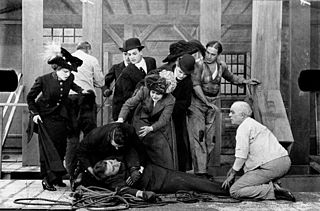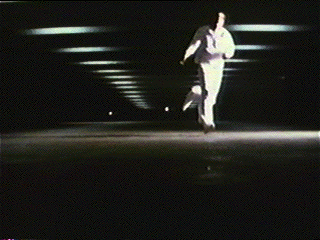
A Corner in Wheat is a 1909 American short silent film which tells of a greedy tycoon who tries to corner the world market on wheat, destroying the lives of the people who can no longer afford to buy bread. It was directed by D. W. Griffith and adapted by Griffith and Frank E. Woods from a novel and a short story by Frank Norris, titled The Pit and A Deal in Wheat.

Eaux d'artifice (1953) is a short experimental film by Kenneth Anger.

The Fall of the House of Usher (1928) is a short silent horror film adaptation of the 1839 short story "The Fall of the House of Usher" by Edgar Allan Poe. The movie was co-directed by James Sibley Watson and Melville Webber, and starred Herbert Stern, Hildegarde Watson, and Melville Webber. It tells the story of a brother and sister who live under a family curse. An avant-garde experimental film running only 13 minutes, the visual element predominates, including shots through prisms to create optical distortion. There is no dialogue in the film, though one sequence features letters written in the air moving across the screen.

Jam Session is a 1942 short film, directed by Josef Berne, which shows Duke Ellington and his orchestra performing "C Jam Blues".
Fuji is a 1974 American animated short by Robert Breer.

Electronic Labyrinth: THX 1138 4EB is a 1967 social science-fiction short film written and directed by George Lucas while he attended the University of Southern California's film school. Lucas reworked the short into the 1971 theatrical feature THX 1138.

Lady Helen's Escapade is a short American comedy film produced in 1909, directed by D. W. Griffith. It is about the escapades of Lady Helen working as a domestic in a boarding house.
OffOn is an experimental film created by Scott Bartlett made and released in 1968.
H2O (1929) is a short silent film by photographer Ralph Steiner. It is a cinepoem showing water in its many forms.
Castro Street (1966) is a visual nonstory documentary film directed by Bruce Baillie.
Mary Ellen Bute was a pioneer American film animator, producer, and director. She was one of the first female experimental filmmakers, and was the creator of some of the first electronically generated film images. Her specialty was visual music; while working in New York City between 1934 and 1958, Bute made fourteen short abstract musical films. Many of these were seen in regular movie theaters, such as Radio City Music Hall, usually preceding a prestigious film. Several of her abstract films were part of her Seeing Sound series.

The National Film Registry (NFR) is the United States National Film Preservation Board's (NFPB) collection of films selected for preservation, each selected for its historical, cultural, and aesthetic contributions since the NFPB's inception in 1988.
Glimpse of the Garden is a 1957 five-minute short experimental film made by Marie Menken, showing film clips of a garden, with birds chirping for the soundtrack. In 1958, the film won an award at the Exposition Universelle et Internationale at Brussels. In 2007, the film was included in the annual selection of 25 motion pictures added to the National Film Registry of the Library of Congress being deemed "culturally, historically, or aesthetically significant" and recommended for preservation.
Free Radicals is a black-and-white animated film short by avant-garde filmmaker Len Lye. Begun in 1958 and completed in 1979, Lye made the film by directly scratching the film stock. The resulting "figures of motion" are set to music by the Baguirmi tribe of Africa.
The Lead Shoes is a 1949 experimental film directed by Sidney Peterson at Workshop 20 at the San Francisco Art Institute. The film was made using distorting lenses. The film is a 17-minute black and white short.

Heroes All is a 1920 American World War I documentary film that was released by the American Red Cross.
Hot Dogs for Gauguin (1972) is a short film written and directed by Martin Brest, then a film student at New York University. The short film features Danny DeVito and Rhea Perlman in her acting debut.
Our Lady of the Sphere is a 1969 American experimental film directed by Larry Jordan.
Study of a River is a 1997 experimental film directed by Peter Hutton.







